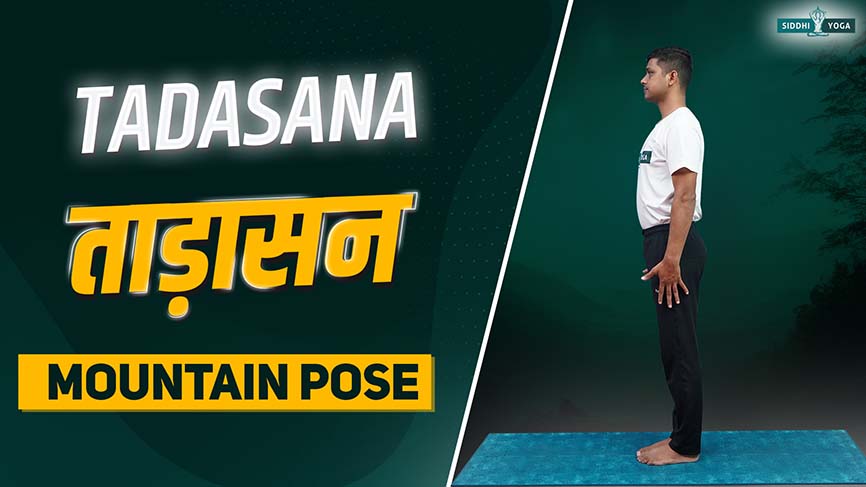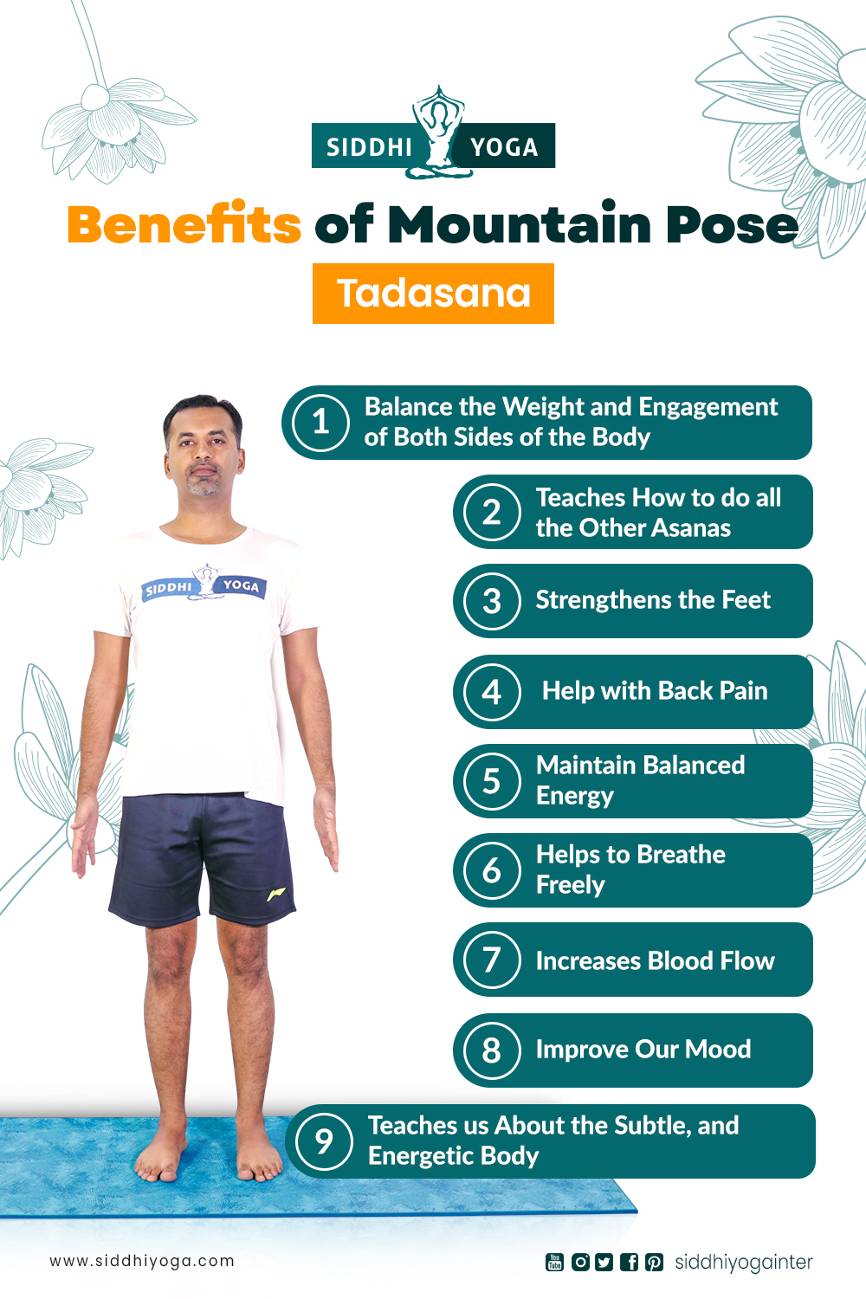
Asana: Pose
Tadasana at a Glance
Tadasana – Mountain pose or Samasthithi, is a basic, foundational pose and a low-impact standing asana. This pose can be a preparatory or in-between pose while performing other asanas.
Benefits:
- Tadasana helps in Correcting your Posture and establishing good alignment.
- It’s also great for finding Stability and balance.
- A firm and grounded posture in this pose can help Strengthen the thighs.
- Improves Awareness and
- It’s believed that long-term practice of Mountain pose may Increase height.
Who can do it?
This asana does not demand great fitness or flexibility and can be easily performed by Beginners, Seniors, Children, people suffering from postural problems, pregnant women, and those with medical conditions such as Parkinson’s disease and COPD.
Who should not do it?
People with severe balance issues, low blood pressure, or any recent leg or back injuries.

How to Do Tadasana?
Follow the Step-by-Step Procedure
Practicing Mountain Pose, or Tadasana, is simple and beginner-friendly. Here’s a step-by-step guide in simple words:
- Stand tall with your feet hip distance and toes pointing forward. Stand on your toes, fan them out, and return to a wider stance.
- Try to distribute your weight evenly on both feet and find your balance well.
- Relax your arms by your sides, and let them hang naturally, palms facing forward.
- Try to lengthen your spine maintaining its natural curve, as if a string is pulling you up from the top of your head.
- Gently tuck your chin in, keeping it parallel to the ground.
- Soften and shrug your shoulders and relax them away from your ears.
- Gently lift your kneecaps to engage your leg muscles.
- Relax your belly and breathe naturally.
- Feel the connection of your feet with the ground, as if you have roots growing into the earth.
- Take slow, deep and fulfilling breaths, and focus on the sensation of each inhale and exhale.
- Be aware of your body, notice how it feels, and find a sense of stillness within.
- Relax all the muscles, including the ones on your face and tongue.
- Stay in the pose for a few breaths or as long as it’s comfortable.
- To come out of the pose, gently release the muscles, slowly relax, and lower your arms.
- Mountain Pose is about finding stability, balance, and a sense of calm. Remember to enjoy the simplicity and power of this pose as you stand tall like a mountain.
What are the Benefits of Tadasana?
Mountain Pose has numerous benefits, especially for beginners.
- Better Posture: It helps you stand up straight and improves your overall posture. You’re not standing in your old style anymore.
- Stronger Core and Stability: Since Tadasana requires the engagement of your tummy muscles and legs, it can strengthen your core and make you more stable.
- Body Awareness: Demands your awareness of how your body feels and moves, and this helps you understand yourself better.
- Feeling Grounded and Stable: You feel more secure and balanced when connected to the ground firmly.
- Mindfulness and Calmness: It helps in improving mindfulness and being present in the moment. That ultimately brings a sense of calmness within.
- Improved Breathing: A lifted chest while performing Tadasana allows for better breathing. And better breathing energizes you.
- Integration of Mind and Body: Tadasana brings together your mind and body and sets the foundation for other yoga poses.
Health Conditions that Might Benefit from Tadasana
Tadasana may be useful in treating health conditions such as:
- Parkinson’s disease: Tadasana helps with Parkinson’s disease by building lower body strength and improving posture and balance.
- Ankylosing spondylitis (AS): Mountain pose is a gentle option to reduce pain related to AS. It also helps to improve posture and increase flexibility.
- Chronic obstructive pulmonary disease (COPD): The emotional and physical benefits of Tadasana are helpful for people with COPD. It can alleviate stress and anxiety while building balance and strength.
Safety and Precautions
- Mountain Pose is generally safe unless you feel dizzy or lightheaded.
- If you are pregnant may need a wider stance to feel stable.
Common Mistakes
- Though Tadasana is a very straightforward and simple asana, you can still go wrong with it.
- Make sure that your alignment and posture are proper with the help of a mirror or a guru. For most, there’s a tendency to go wrong in the alignments.
- Also, take your time with the process, and try to be attentive and mindful to yield the benefits.
Tips for Tadasana
- Stand with your heels and shoulder blades against a wall.
- If you are not sure about your posture and alignment.
- Keep your feet three to five inches apart to better balance.
The Physical Alignment Principles of Tadasana
- Just as in other standing poses, achieving the correct physical alignment is key in the Mountain pose.
- It involves standing tall with feet grounded, legs engaged, spine lengthened, shoulders relaxed, and head aligned with the spine.
- However, it’s not just about the external alignment. Body awareness and engagement also play vital roles.
- You need to be aware of your body and its sensations in the pose in order to make adjustments and maintain proper alignment. Also engaging the appropriate muscles creates stability and strength.
- When you bring alignment, body awareness, and engagement together, Tadasana can be a magical pose that connects your mind and body in a beautiful way.
Tadasana and Breath
In Tadasana, the posture itself sets the stage for optimal breathing. You expand your chest to the fullest when standing tall and properly aligning your body. As you lift your chest and elongate your spine, you get better airflow, allowing deeper breaths.
While in the pose and directing your attention to your pose, you are entering into a state of conscious breathing.
Become aware of your inhalations and exhalations. Focus and feel the breath entering your nostrils, traveling down to your lungs, and then observe as you gently release and exhale. You do not have to force or alter the breath movement but just notice and feel its rhythm. Let the breath flow at its natural pace effortlessly.
Conscious breathing can be a tool to bring us great relaxation and release. When you exhale, try to let go of any tension or stress that you are holding. This breath awareness in Tadasana connects you with the present moment and brings you a state of mindfulness.
When you bring breath awareness to Tadasana, you create a bridge between your practice’s physical and energetic aspects.
The breath acts like a channel for life force energy called prana, which flows through your body. When prana flows freely, it boosts your energy levels and vitality.
Tadasana and Variations
You can try different variations of Mountain pose as per your abilities or to challenge yourself more. Below are a few variations that you could explore;
- Tadasana Paschima Namaskarasana (Standing Reverse Prayer Pose)
- Urdhva Hastotanasana (Palm Tree Pose)
- Tadasana Paschima Buddha Hastasana (Back Bound Hands Pose)
- Tadasana Gomukhasana (Standing Cow Face Pose)
The Bottom Line
In summary, the Mountain Pose can be a perfect and powerful foundation pose and also a perfect in-between pose for both beginners and seasoned yogis alike. You can easily integrate this pose into your daily life because of its simplicity and accessibility, helping you find stillness and strength in your fast-moving lives.
This pose teaches us the importance of grounding, stability, and self-awareness, not just on the yoga mat but also in our daily lives.
“Discover the power of Tadasana – the mountain pose – for inner strength and balance in your yoga practice! Ready to take your yoga journey to new heights? Enroll now in our online yoga courses and deepen your practice today! We offer a wide range of certified yoga programs, 200-Hrs RYT Yoga TTC and 300-HRS RYT Yoga TTC and much more.
Me interesa tomar los cursos de yoga de Siddhi yoga. Que duración tiene el diplomado. El costo costo de usd. 347 dólares, corresponde a cuánto tiempo de estudio
Por favor me puede informar horarios de clase en Zoom
Yo vivo en Quito – Ecuador. Gracias